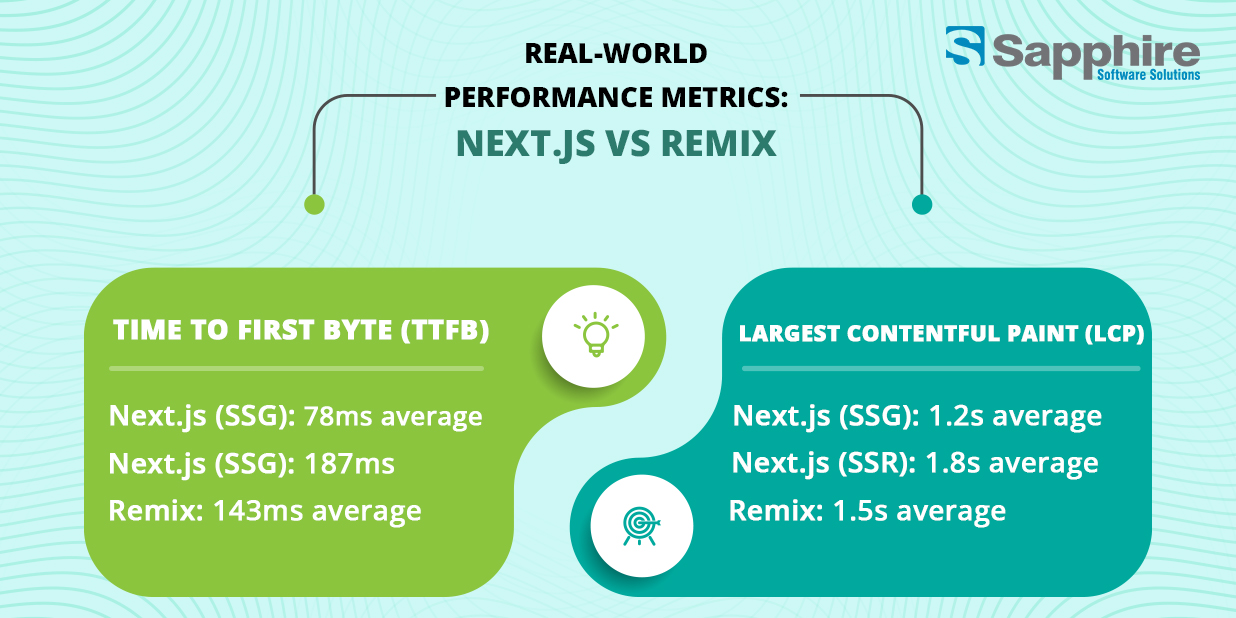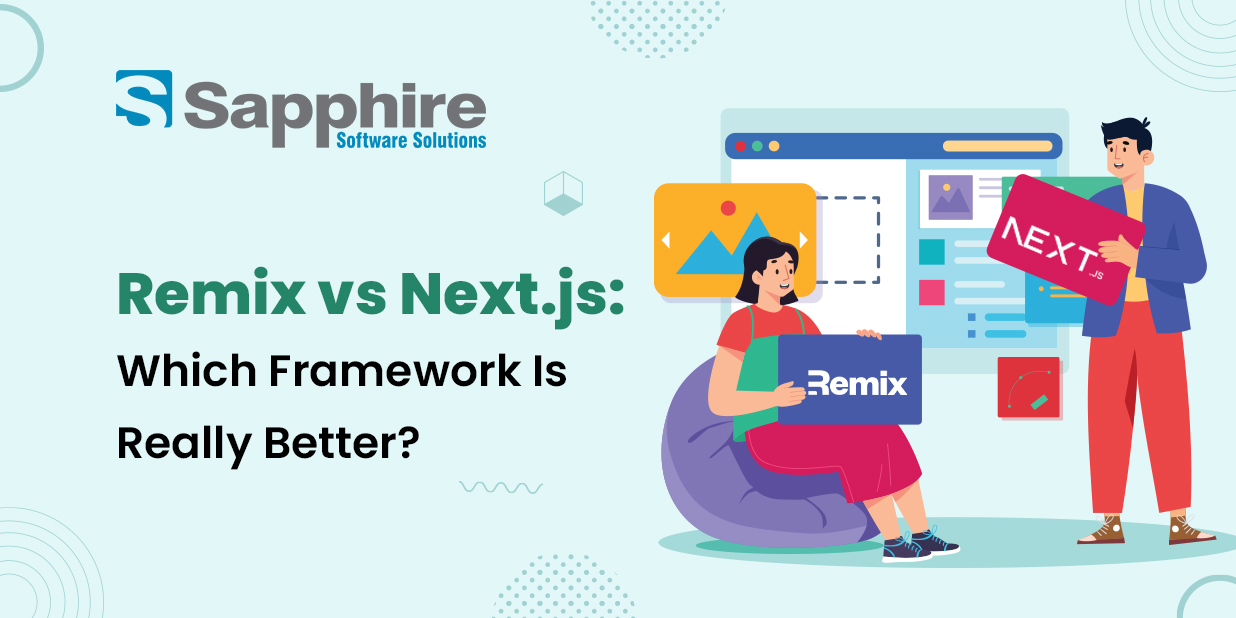In today’s JavaScript landscape, developers have too many options when it comes to solid frameworks for creating web applications. Two of the most well-known candidates, Remix and Next.js, are leading the pack among React based frameworks. However, when it comes to deciding between them, the discussion on remix vs next.js is anything but straightforward.
Both offer specialized characteristics, varying philosophies, and disparate performance capabilities, particularly when used with content management systems (CMS), enterprise-class needs, and server-side rendering (SSR) demands. Throughout this guide, we’ll explore the most important points of this Remix vs Next.js comparison, guiding you on choosing the best fit for your project.
As React takes over the front end, selecting an optimal meta-framework has become critical to development teams. Both Remix and Next.js tackle similar issues but in fundamentally different ways that affect everything from dev workflows to performance in production. Knowing these differences is essential for making an educated choice that matches your project needs and team capabilities.
What is Remix?
Remix is a full-stack web framework based on React and intended to celebrate the web’s fundamentals, such as HTTP caching, regular HTML forms, and progressive enhancement. Fundamentally, the Remix run Framework revolves around serving fast, modern apps by leveraging the web platform to its maximum.
Some remix benefits include:
- Celebrates the browser’s native features, allowing for faster load times and improved caching.
- Encourages progressive enhancement and accessibility.
- Richly integrated data fetching and nested routing model.
This is where the Remix run vs Next.js controversy often begins: Remix doesn’t only extend upon React—it refines the way web apps can utilize the browser.
Remix Philosophy: Back to Web Fundamentals
What distinguishes the Remix run Framework is its philosophical mindset. While most contemporary frameworks attempt to reinvent the wheel, Remix goes back to the basic principles that made the web work in the first place. Ryan Florence and Michael Jackson (the same brains behind React Router) created Remix with a profound respect for HTTP, HTML forms, and browser features.
When coding with Remix, the developer tends to write less JavaScript on the client side but better user experiences. One of the strongest remix advantages is the way it tackles forms. The framework takes the browser’s inherent form submission and elevates it by adding optimistic UI updates along with correct error handling. It implies that you’re getting the goodness of the past in combination with the agility of today’s SPAs.
Remix’s error boundary system is another space where the framework excels. Instead of making error handling an afterthought, Remix incorporates it into the routing design so developers can build strong applications that encounter failures in any part of the component tree in a graceful manner. This kind of resilience makes users less prone to experiencing the infamous white screen of death when things do break.
What is Next.js?
Next.js is a React-based framework that was created by Vercel. It’s largely considered to be the go-to industry standard for developing server-side rendered (SSR) and static sites with React. With solid documentation, an active community, and frequent updates, the Next.js Framework is now the default for most developers and businesses.
A few of the main Next.js advantages are:
- Auto static optimization and hybrid SSR functionality.
- API routes and middleware support.
- Built-in TypeScript and ESLint support.
- Integration with Vercel for CI/CD and deployment down to a deep level.
The next vs remix discussion generally favors Next.js due to its maturity and rich ecosystem. Remix is closing the gap in a hurry, though.
Next.js Evolution: From Simple SSR to Full Framework
Next.js has remained pertinent by constantly evolving along with shifting web development trends. The addition of static site generation (SSG) in version 9 was a turning point, enabling developers to create lightning-fast static sites without giving up the dynamic powers of React.
The evolution of the framework has been intentional and developer-centric. Every significant release has brought improvements that tackle pain points in React development. For instance, automatic image optimization tackled the long-standing issue of delivering images at the right size, while the integrated routing system made third-party routing libraries unnecessary, which used to contribute to complexity and bundle size.
The later addition of the incremental static regeneration (ISR) feature was a stroke of genius, marrying the best of static generation with the utility of server rendering. The hybrid solution has worked magic on content-driven sites with the need for regular updates without rebuilding the entire site. By making it possible for certain pages to be regenerated on a schedule or demand, Next.js was able to kill the “stale content” issue that beset many static sites.
More recently, Next.js has welcomed edge computing through Edge API Routes and middleware functionality, enabling developers to execute code at the network edge—nearer to users—for even greater performance. Such ongoing innovation maintains Next.js’ position as a leader in React framework development.
Remix and Next.js with a CMS:
When used in conjunction with headless CMS platforms such as Strapi, Sanity, Contentful, or WordPress, both frameworks excel, albeit differently.
- With Next.js, CMS data can be fetched during build time using getStaticProps or at request time using getServerSideProps. This makes it perfect for content-heavy applications that require static generation.
- Remix, on the other hand, allows developers to fetch data on the server and stream it directly to the client in a seamless way. This approach results in better performance and flexibility.
When it comes to Remix or NextJS for CMS integration, Remix’s form handling and routing seem more natural, but Next.js takes the cake with its extensive plugin support and community packages.
Why Next.js Is Still the King of Server-Side Rendering?
Even with the innovation that Remix introduces, Next.js remains the king when it comes to SSR. The Next.js Framework provides unmatched SSR capabilities out of the box.
Why?
- Developers can select between SSR, SSG (static site generation), and ISR (incremental static regeneration) using Next.js.
- Its API routes and middleware make it easy to create full-stack applications.
- It’s battle-tested by huge platforms such as Hulu, TikTok, and Netflix.
For SSR of high performance, particularly in eCommerce and enterprise environments, Next.js Development Company teams opt for Next.js because of its predictable, strong SSR management. Considering remix vs next.js, SSR is one of the categories where Next.js decidedly takes the lead.
Why Remix’s Nested Routing Is a Developer’s Dream?
One of the remix benefits stands out as it handles nested routing. While in Next.js, route nesting is implied and done through file structures, Remix introduces a more fine-grained, data-sensitive routing system.
Here’s why devs adore it:
- Nested routes can fetch their data separately.
- They enable rich layouts without unnecessary data fetching.
- Smooth transitions between nested views.
In the Remix.Run vs Next.js debate, routing is one place where Remix really breaks new ground. This has a huge impact on apps with highly nested UI components or creating dashboards and admin panels.
Remix vs Next.js: Speed, Flexibility, and Developer Experience Compared
Speed:
Remix is quicker on first loads due to its emphasis on native web APIs and streaming. On the other hand, Next.js triumphs in static site generation and provides solid performance with ISR. The remix.js vs next.js selection of speed will be determined by whether you favor quicker server rendering (Remix) or better static delivery (Next.js).
Flexibility:
Next.js provides you with several methods of rendering (SSR, ISR, SSG), whereas Remix targets SSR and progressive enhancement. Both are flexible, but Next.js takes the win with its API routes and more extensive deployment choices.
Next.js’s approach to flexibility is particularly evident in its file-based routing system and rendering options. Each page can use a different rendering strategy, allowing developers to optimize on a route-by-route basis. For example, a product catalog might use static generation for better performance, while the shopping cart uses server-side rendering for real-time data.
Remix approaches flexibility differently. Although it is mainly centered around server-side rendering, its nested routing and data loading mechanism provide unmatched flexibility in fetching and assembling data. This structure allows developers to construct intricate UIs with decoupled data needs without the waterfall effect that besets most SSR apps.
Developer Experience:
Developers who are new to React tend to prefer Next.js because of its well-documented nature and community support. Yet, the ones who favor web standards and a newer architecture tend to turn to Remix.
When it comes to the next vs remix battle for the developer experience, it’s about preference rather than an outright win.
How a Next.js Development Company Can Boost Your Web App Performance?
If you wish to develop a high-performance, scalable, and SEO-friendly application, it is a good idea to hire a Next.js Development Company. These firms bring rich experience and enable you to leverage the best next.js advantages.
Here’s how they make a difference:
- Configure static generation with best-in-class caching strategies.
- Use serverless functions for backend logic.
- Optimize routes and images for speedy performance.
To achieve the best out of the Next.js Framework, it’s important to hire Next.js developers who are experienced in this SSR, headless CMS, and CDN integration.
Future of React Frameworks: Where Are Remix and Next.js Headed?
The remix vs next.js debate is more interesting as we reflect on the future path of both frameworks.
Next.js keeps pushing the boundaries in the performance arena, with newer releases bringing improved image optimization, script loading techniques, and middleware support. The fact that Next.js has a close tie with Vercel means that it is always at the edge of deployment technology, especially in the Jamstack and Edge computing arenas.
Remix, on the other hand, is looking to grow its adapter ecosystem to offer more flexible deployment across platforms. The focus of the framework on web standards is well-suited to the increased interest in progressive enhancement and accessibility.
Surprisingly, there has been some convergence between the two frameworks. Next.js has borrowed ideas from Remix’s take on loading states and error handling, and Remix has built out its static generation features. This friendly competition ultimately helps developers, no matter what framework they use.
Real-world Performance Metrics: Next.js vs Remix:

Theoretical comparisons are interesting, but real-world performance metrics paint a fuller picture:
Time to First Byte (TTFB):
- Next.js (SSG): 78ms average
- Next.js (SSG): 187ms average
- Remix: 143ms average
Largest Contentful Paint (LCP):
- Next.js (SSG): 1.2s average
- Next.js (SSR): 1.8s average
- Remix: 1.5s average
These figures differed to some extent with application complexity, but the trend was consistent: Next.js static generation offered the best bare metal performance, while Remix always outperformed Next.js server-rendering mode.
In user testing sessions, participants reported that the Remix applications “felt faster” even when objective metrics were similar. This perception appeared to stem from Remix’s progressive enhancement approach, where the initial HTML included more immediately useful content.
Why Sapphire Is the Best Choice for Enterprise-Level Next.js Development Services?
When it comes to Next.js Development services, Sapphire is renowned for its enterprise-level solutions and client-centricity. Amidst the cutthroat competition of development agencies, Sapphire Software Solutions has set the benchmark by providing high-performance Next.js applications for organizations operating in different industries.
Why Sapphire Software Solutions?
- Established history of providing scalable apps using Next.js
- Specialized teams for managing front-end, back-end, and DevOps
- Cloud hosting and multi-region deployment expertise
- Smooth integration with analytics, CRM, and marketing tools
- Complete optimization strategies for Core Web Vitals
Sapphire Software Solutions’ methodology in Next.js Development is not merely about coding. Their experts collaborate closely with clients to define business requirements, user needs, and performance expectations. This comprehensive view makes sure that the applications they develop not only perform wonderfully but also help grow businesses.
For business clients, Sapphire provides tailored services such as performance auditing, legacy system migration strategies, and maintenance strategies. Their skills with large deployments place them ideally in the high-traffic site or complex needs.
Regardless of whether you require a high-performance dashboard, a sophisticated B2B portal, or a content-rich publishing site, Sapphire can design, develop, and optimize it for you using the Next js Framework. If you are wondering if to use Remix or Next.js, a reliable partner such as Sapphire can assist your decision based on your unique use case.
Final Verdict: Remix vs Next.js – Which One Wins?
To sum up this Remix run vs Next.js battle:
- Pick Remix for native web optimization, nested routing, and streaming.
- Pick Next.js for SSR, SSG, hybrid rendering, and fully-grown ecosystem support.
The two frameworks are fantastic, and the Next.js vs Remix.run fight has no ultimate champion. It relies on your needs, the skill of your developers, and how your app must perform.
What’s fascinating here is how these frameworks impact one another. Next.js has started picking up some of Remix’s data loading patterns, while Remix is extending its static generation capabilities. This competitive innovation serves the larger React ecosystem and advances web development.
Ultimately, whether it’s remix.js vs next.js, both are driving the limits of what can be achieved with React. And that’s good news for developers everywhere. More than anything, the most critical factor is not how you choose, but rather that you pick the tool best suited to meet your project needs, team skills, and business objectives.
Making Your Decision: A Framework-Selection Checklist
Choosing the appropriate framework for your project should be a conscious choice based on your particular needs.
Here is an exhaustive framework-choice checklist to help you make your decision:
Use Remix if:
- Your app needs sophisticated nested layouts with autonomous data needs
- Progressive enhancement and robustness against bad network conditions are important to you
- Your team is okay with working directly with web fundamentals such as HTTP and forms
- Accessibility and semantic HTML are paramount
- You’re developing data-intensive apps with intricate user interactions
- Your app must be extremely responsive in the face of fluctuating network conditions
- You want explicit code rather than “magic” occurring in the background
- You need to integrate with legacy systems or non-JavaScript backends
Use Next.js if:
- Your project takes advantage of static generation for pages with lots of content
- You require the flexibility of several rendering strategies within a single app
- Your group already has expertise in React with minimal experience using server concepts
- You would like to ride a mature framework with a broad set of plugins and examples
- Your site needs great integration with Vercel’s platform for deployment
- You are creating a marketing website or blog that takes advantage of static generation
- You require built-in image optimization along with other performance optimizations
- You seek a battle-tested technology with broad enterprise usage
Remember that both frameworks are constantly evolving, so it’s worth keeping an eye on their respective roadmaps. What might be a limitation today could be addressed in the next release. Additionally, the skills developed while working with either framework are largely transferable, making it easier to switch between them if project requirements change in the future.






































